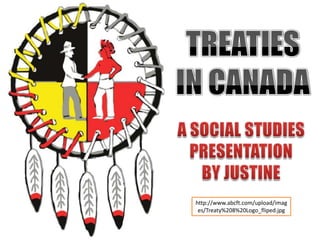Treaties in Canada
- 1. TREATIES IN CANADAA SOCIAL STUDIESPRESENTATIONBY JUSTINEhttp://www.abcft.com/upload/images/Treaty%208%20Logo_fliped.jpg
- 2. PEACE AND FRIENDSHIP TREATYhttp://media.photobucket.com/image/peace%20filterui:imagesize-large/brent31_2oo9/patient.jpg
- 3. ROBINSONTREATIESOjibwa chiefs and The CrownExchange of land for smaller reserves and moneyhttp://rpmedia.ask.com/ts?u=/wikipedia/commons/thumb/2/2a/Caa-tou-see.jpg/72px-Caa-tou-see.jpg
- 4. SELKIRK TREATY OF 1817http://lenapedelawarehistory.net/mirror/PHOTOS/William%20Penn%27s%20Treaty%20with%20the%20Lenape%20Chiefs%20at%20Shackamaxon%20in%201682.jpg
Editor's Notes
- #2: Treaties In CanadaJustine HallFebruary 14, 2011Social Studies 9/10
- #3: WHO: Mi'kmaq, the Maliseet, and the Passamaquoddy (the Wabanaki) were the First Nations that signed the treaty. The British part of the treaty was signed by Lawrence Armstrong and John Doucett, who were the colony's principal military leaders. WHAT: The treaty was called The Peace and Friendship Treaty. This treaty consisted of two different documents. The first document was signed by the Wabanaki, and the second document was signed by the British. Both of these documents include the promises each group made to each other.WHEN: The Peace and Friendship Treaty was signed in 1726.WHERE: The area that the treaty was signed is now Nova Scotia and New Brunswick.WHY: The treaty was first signed to bring an end to a three year war between the Wabanaki and New England. Its main purpose was to steady the interaction between the Wabanaki and the British and to split up their alliance with the French. The treaty set up laws concerning the relationships between the British and the First Nations people in the area. Another part of the treaty dealt with the land. The First Nations agreed not to meddle with already existing settlements, while the British agreed not to interfere with the First Nations planting or hunting.
- #4: WHO: The Ojibwa chiefs and The Crown signed the Robinson Treaties.WHAT: There were two treaties, which were called the Robinson-Huron treaty and the Robinson-Superior treaty.WHEN: The Robinson Treaties were signed in 1850.WHERE: The treaties were signed on the shores of Lake Huron and Lake Superior.WHY: The treaty was signed so The Crown could own 50,000 mi2of land which previously belonged to the First Nations in the area. In exchange for the land, the First Nations received money and 3 new reserves. The Crown agreed that the Ojibwa people could hunt throughout their surrendered territory because it was previously theirs.
- #5: WHO: Cree, Chippewa, Saulteaux, andKillistine, First Nations and Thomas Selkirk where the people who signed the treaty.WHAT: The treaty was called The Selkirk Treaty.WHEN: The treaty was signed in 1817.WHERE: The area that the treaty was signed was along the Red River, which is now in Manitoba. WHY: Thomas Selkirk created the treaty so the First Nations would give up their territory for the settlement of Europeans. In return, the Cree, Chippewa, Saulteaux, andKillistine, First Nations each received tobacco every year.




